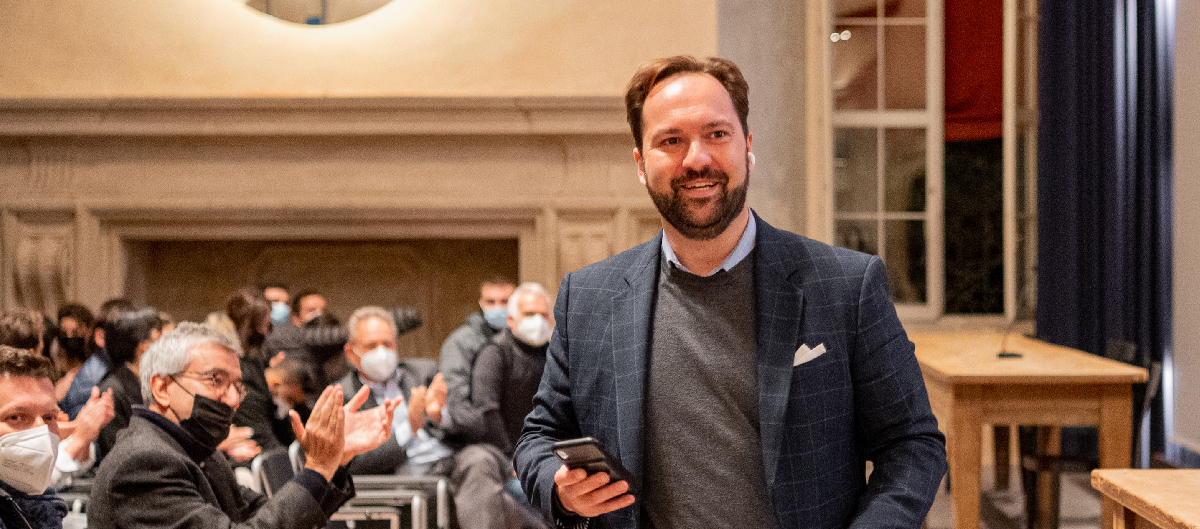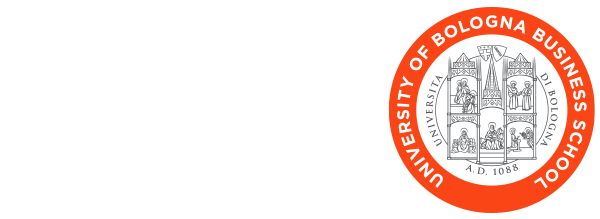
INNOVATION TALKS – Christian Ferri, “Blockchain and Innovation”.
25 January 2022In the lecture hall “Nino Andreatta” of Villa Guastavillani start the first talk of Innovation Talks 2022, an event held both in presence and online. At the opening, DEAN Max Bergami introduces Christian Ferri, CEO of Geer™ and author of the essay Blockchain & Made in Italy. Istruzioni per l’uso. In conversation with Ferri, Rebecca Montanari, Professor of Cybersecurity and Pro-Rector for Digital Transformation at the University of Bologna.
Topic of the meeting: the blockchain. What it is and what will be its role in the innovation of business models, in the relationships between people, companies and public administrations.
Ferri starts his speech with some clarifications: the word blockchain today is often used out of context. There is a lot of hype around the technology on which virtual currencies are based (Bitcoin), and we need to review the concept behind the term blockchain, to analyze its current uses and to study its innovations.
Ferri quotes Bill Gates: “Blockchain is a technological tour de force.” Microsoft has based its fortune on technologies opposed to blockchain, and if, despite this, its founder recognizes its importance, it deserves attention.
To give a definition of blockchain is complex. We can say that blockchain is a shared, immutable ledger that facilitates the recording of transactions and tracking of assets in a commercial network. Block means data and Chain means a system of connections. It is a particular type of Distributed Ledger (DLT), where transaction data is put together in blocks that are connected in a time sequence and placed in the ledger. In this way, the information stored, once inserted into the ledger, and validated, is unalterable because each new information is linked to the history of previous transactions: any manipulation of the data would be immediately evidenced, not allowing further validations.
What the goal? To decentralize information by cutting and encrypting data blocks. To distribute the flow of information, separated from a unique and centralized source; to make transparent all the passages and the data itself, which is crystallized forever in a Block, put in relation with the others through the Chain connection system.
The point of blockchain is not to be a trust maker, but to make possible a transaction or a cooperation with another entity that we cannot trust.
Trust is the central theme of the first part of Ferri’s speech. It is easy to think back to Francis Fukuyama’s 1995 essay Trust, an analyzing the social and economic dynamics of the neo-globalized world. The topic was precisely trust: the base of the large corporate and the related Civil Society that are the foundations of the State and the capitalist system.
Now, Ferri says, we need to transcend the concept of trust and replace it with that of Smart Contracts: transaction protocols designed to automatically execute, to control or to record legally relevant events and actions according to the terms of a contract or agreement. The aim is to reduce the need for trusted intermediaries, to prevent fraud and to reduce mistakes. The blockchain technology platform is optimal for the purpose of the Smart Contracts: automation, transparency and security.
But then, what can blockchain technology and its digital protocols be applied to? Potentially to everything. As it is an authentication method that eliminates intermediaries and certifying authorities, these protocols can be used for several applications: the products tracking; the multimedia contents that can be uploaded on a platform (for example, Spotify) without further intermediaries other than producer, digital structure, and user; a private photovoltaic system could sell excess energy without big energy distributors.
Ferri sums up: “Blockchain is when you have to deal with a person, an entity, a government, an institution outside your firewall, someone you have no reasons to trust”. Currency is a separate chapter. Ferri says that 90% of tax fraud occurs with cash. Replacing it with virtual currency, traceable in every step from the creation to its final use, would eliminate these types of crimes. It would also reduce the costs of producing, printing, storing, and distributing bills and coins. Bitcoins and other virtual values can be a secure, transparent, traceable, and low-cost alternative to currencies issued by Central Banks around the world.
Another topic, NFTs. An NFT is a unit of data stored on a digital ledger (blockchain) that can be sold and traded. The NFT can be associated with a particular digital or physical asset (such as a file or object) and a license to use the asset for a specific purpose. It can be traded and sold on digital marketplaces, as well as the licenses. The NFTs act as cryptographic tokens, but differently from cryptocurrencies like Bitcoin or Ethereum, NFTs are not mutually interchangeable, so they are not fungible.
The blockchain becomes the platform for an infinite number of possible operations: from parametric insurance policies that use smart contract protocols, to online tickets sale, to advertising with QR codes that allow to use Scan & Buy services, to the traceability of any kind of product (very used in the luxury market).
“What will society look like after the mass adoption of DLT technologies?” asks Ferri in conclusion. “We can’t know what we don’t know,” he replies. New technologies change rapidly: we know what it is today, but not what it will become tomorrow. The intent to simplify, to free information from certifying authorities and at the same time make it safe, secure and crystallized, allows people to access services, bypassing a huge amount of paperwork and bureaucratic steps with full security of their information. However, the same information could be accessible for us and others, perhaps could be used by evolved artificial intelligences.
“Will the future be as tragic as the one of Skynet in Terminator?”. concludes Ferri. Our identity and our data are the most important assets to us in the digital world: we should be aware and be more careful about how we spread this information, especially through social media. We need to be vigilant and use technology that allows us to store, preserve and protect data by preventing anyone from using it without our knowledge. We cannot know what will happen in the future, but we can secure what we need to protect right now.
